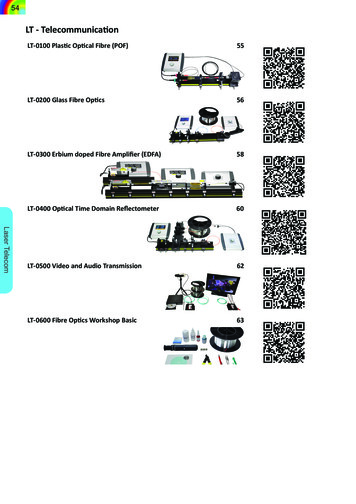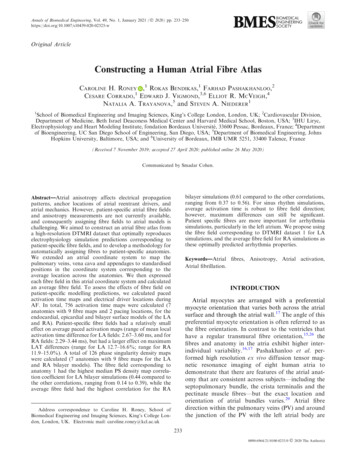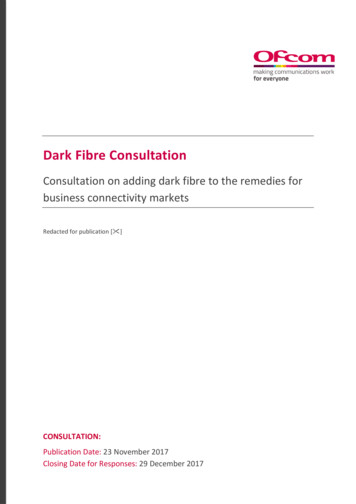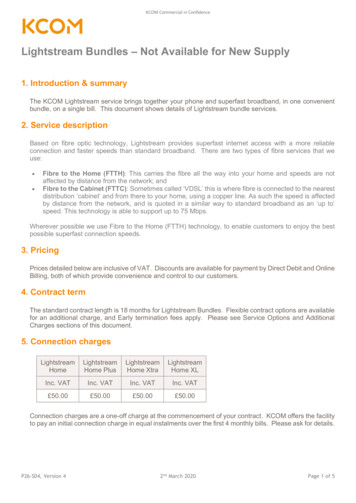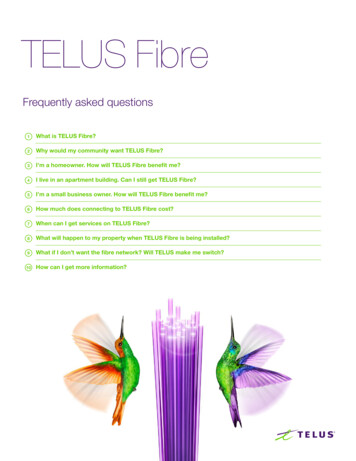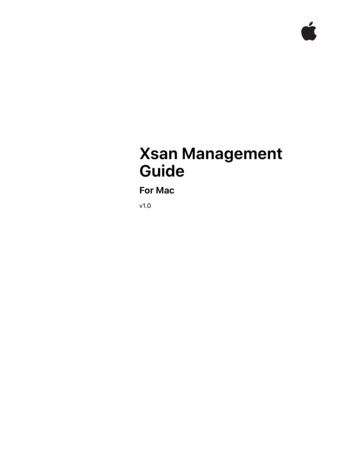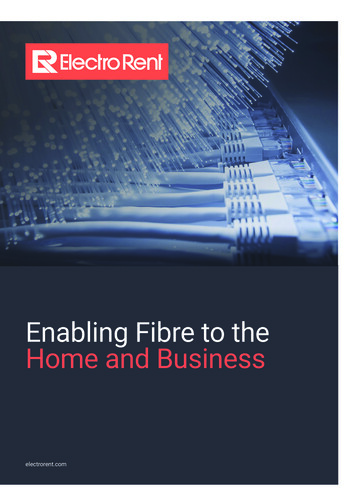
Transcription
Enabling Fibre to theHome and Businesselectrorent.com1electrorent.com
IntroductionThis paper looks at full fibre networks – Fibre-to-the-Home,(FTTH) and Fibre-to-the Premises, (FTTP), reviewing howbroadband services in the UK have evolved to the currentpoint where FTTH/P networks are beginning to be rolled out.The benefits of full-fibre networks are discussed and the UKdeployment status is covered.The imminent surge in FTTH/P installations will fuel a demandfor engineering manpower as well as the necessary toolsand equipment. The most commonly used test equipmentfor FTTH/P is reviewed and the benefits of an independentsupply chain partner, such as Electro Rent and Electro Rent, arepresented.Broadband, or “always on” services were first introduced to theUK in 2000 and were provided by the cable companies of the day(NTL, Telewest ) over their co-axial infrastructure and BT, usingADSL technology over existing copper lines. Download speedat that time was 512 kbps and broadband roll-out was slow atfirst with only 9% of UK homes having a broadband connectionby the end of 2001, compared with 30% in Germany and 40%in Sweden. It wasn’t until 2008 that UK broadband penetrationrose significantly with 1.5 million new customers added thatyear and 50% of the population having access by 2009.Arguably the catalyst for this surge in penetration was theintroduction in 2008 of fibre-based broadband by Virgin Media,who had by then consolidated all of the previously independentcable franchise assets into a UK wide network. Using theirFibre-to-the Curb (FTTC) based service Virgin Media wereable to offer download speeds of 50 Mbps, around twice thatof BT’s highest speed at that time. Ofcom, the UK regulator,also tried to stimulate broadband growth by first ordering BTto separate their network’s operation into a separate operatingdivision, BT Openreach, and then by requiring BT Openreachto offer unbundled Local Loop access, (LLU). LLU generated anumber of new market entrants, including AOL, Tiscali, Cable2& Wireless, Talk Talk and Carphone Warehouse, which hasbeen reduced through market consolidation to a small number,including Vodafone.In 2011 Hyperoptic launched the first true fibre-to-the-home(FTTH) service in London, providing speeds of 1 Gbps, incomparison to Virgin Media’s flagship 100 Mbps service.This event marked the start of FTTH services in the UK withBT announcing plans in 2012 for full-fibre services. As withbroadband back in 2000 however, the roll-out has been slow,with many false dawns following ambitious governmentcommitments, (subsequently withdrawn), and complaints ofBT stifling the market. In 2016 Ofcom finally ordered BT todevolve Openreach into a completely separate company andat the same time announced a series of measures, (see below),designed to accelerate the roll-out of full fibre networks.Whilst most high-speed broadband access today is still basedon FTTC networks, full-fibre is the next evolution in broadbandservices promising 1Gbps (and higher) upload and downloadspeeds. Roll-out of these services in the UK currently lagsbehind that of most of our European neighbours but, driven bythe potential threat to the UK economy caused by the lack ofa high-speed broadband infrastructure, the government hasannounced a package of measures designed to encourage thesupply side of the market.A number of operators, led by BT Openreach, Virgin Media andVodafone/City Fibre, have now announced ambitious roll-outplans for full-fibre networks which will increase the number ofhomes passed from the current level of 1.2 million up to 25million or more by 2025.electrorent.com
Operators haveannounced ambitiousroll-out plans for fullfibre networks toincrease the numberof homes passed from1.2 million to 25 millionor more by 2025.3electrorent.com
FTTHAs demand for high speed internet access continues to growexponentially, traditional access technologies such as ADSLare no longer fit for purpose and are being superseded by fasteraccess technologies. Over the last 10 years or so the main UKnetwork operators such as BT Openreach, Virgin Media andVodafone have been rolling out super-fast networks, based on“fibre to the curb” technology, (FTTC), which enable downloadspeeds up to 100 Mbps. FTTC networks use a mix of fibre andcopper cables, with the operator deploying fibre to the (usuallygreen) street cabinet from where the connection to the homeis made over existing copper infrastructure, which may bedecades old. (Although Virgin Media use their existing coaxialcable infrastructure instead of copper). The copper sectioncan limit the connection speed due to its age, its length or thenumber of customers who may be sharing it.Fibre to the Home, or Fibre to the Premises (FTTH/P) networkseliminate the copper section and deliver fibre directly tothe building, enabling faster download and upload speeds.The different FTTC/FTTH/FTTP network configurations areillustrated in Figure 1, right.Access LoopCO/POFibre To The Curb (FTTC)Fibre To The Distribution point (FTTDp)Current FTTC-based high speed broadband networks can offerdownload speeds of up to 100 Mbps to the end user, whereaswith today’s FTTH networks, download and upload speeds of1 Gbps are achievable. Table 1 puts this into perspective bycomparing upload and download speeds for popular homeapplications.Table 1 below: Comparison of Upload and Download Speeds.(Source: Fibre to the Home Council Europe)Time taken for:1 GB photo album4.7 GB standard video25 GB HD video1 Gbps download1 Gbps upload9 sec39 sec3 min 28 sec100 Mbps download100 Mbps upload1 min 23 sec6 min 31 sec34 min 40 sec50 Mbps download10 Mbps upload2 min 46 sec13 min 52 sec13 min 2 sec1 hr 5 min1 hr 9 min5 hr 47 min8 Mbps download1 Mbps upload19 min 0 sec2hr 32 min1 hr 29 min11 hr 54 min7 hr 55 min-4electrorent.com
FTTHStandards for PON networks are set by the InternationalTelecommunication Union, (ITU), and are constantly evolving;today’s networks adhere to Gigabit PON, (GPON), but furtherevolutions of PON will enable operators to increase capacity,end users and bandwidth. Figure 3 shows the current variantsof PON standards.Recent progress in ITU-T PON standardsG.hsp.xHigher speedPONReq, PMD, TCDown-/Up-stream Data Rate (bps)There are two main architectures for FTTH networks, as shownin Figure 2, Point-to-Point and Point-to-MultiPoint, with thelatter accounting for the largest number of deployments todate. Point-to-MultiPoint or Passive Optical Networks (PON)save dramatically on fibre costs by aggregating multiplecustomer lines using a branching tree of fibres and passivesplitter/combiner units. The passive optical splitters enablea single fibre to serve between 32 and 128 premises. Thefibre section from the splitter is normally terminated on theoutside wall of a home, and a short fibre lead run inside to thefibre modem, which then offers an Ethernet connection to abroadband router. On PON networks, downstream or transmitlight is transmitted at 1490 nm and upstream or receive at 1310nm. For “triple play” systems where video is broadcast over thenetwork, wavelength-division multiplexing (WDM) is used toadd a further wavelength at 1550 nm to carry the video signals.NG-PON2TWDM 4 /., 10G/10GPtT WDM 8 /., 10G/10GG.989.xB-PON622M/155MG.983.xPoint of PresencePON(P2MP)Acces loopIPPON 25GG.984.x2005201020152020Figure 3: PON standardsOpticalSplitterFibreEthernetCustomer PremiseXGS-PONXG-PONG-PONFibre(Source: The International Telecommunications Union)IPEthernet OLT(switch)FibreFigure 2: Different FTTH Architectures(Source: Fibre to the Home Council Europe)5electrorent.com
UK Roll-OutAs demand for high speed data services continues to growexponentially, governments in the developed world recognisethe importance to their economies of high speed broadbandinfrastructure. A recent report published by the FTTH CouncilEurope shows that, with full-fibre broadband available toaround 4% of buildings, the UK is ranked 15th in the sample ofEuropean countries and, in terms of subscriber take-up, is wellbehind countries like Sweden and Latvia, who have more than40% penetration.To address this, the UK government has committed to makefull fibre broadband available to at least 10 million homesand businesses by 2022 and, over the last 18 months hasannounced a package of measures to address this, including: 67 million investment in the Nationwide Gigabit BroadbandVoucher Scheme (GBVS) to help homes and small businesseswith the cost of connection Establishment of a 400 million Digital InfrastructureInvestment Fund Launch of the 200 million Local Full Fibre Networks (LFFN)programme – providing targeted funding to stimulatedemand and prove commercial models. Introduction of 5-Year business rates relief for new fibre. Creation of the Barrier Busting Taskforce who are workingclosely with local authorities and suppliers on removingobstacles that are preventing the widespread commercialdeployment of full fibre connectivity.6Additionally, the Government’s Future Telecoms InfrastructureReview has issued a series of proposals including guaranteedfibre in new developments and providing operators witha ‘right to entry’ to flats, business parks, office blocks and aunified approach to street works to reduce the cost and time ofdigging up roads. The review also proposes opening pipes andsewers owned by power and water companies and allowingunrestricted access to Openreach’s duct and pole network toother telecoms companies. Rural areas where the governmentwould need to stimulate investment have also been highlighted.Within this environment a number of UK operators haveannounced plans to invest in full-fibre networks. Thedeployment business case for these operators has beenpositively impacted by the above government measures as wellas the regulatory framework created by Ofcom. Additionally,new developments such as narrow trenching, overhead fibre,flat micro-ducting systems and pre-terminated cables havehelped to further reduce costs.Table 2 summarises the plans announced by the mainoperators which indicates that, if all of the respective roll-outsare achieved, the number of households and business premisespassed will rise from an estimated 1.2 million (April 2018) toover 25 million by 2025.Table 2: Summary of UK full-fibre roll-out plansOperator2018 (Q1)2020BT OpenreachVirgin MediaVodafone/City ,000350,00040,0003 million2 million1 million150,000Total1.2 million2022202510 million5 million5 million2 million5 million25 million electrorent.com
UK Roll-OutThe 3 main players in the UK full-fibre market are currently BTOpenreach, Virgin Media and the recently announced jointventure between Vodafone and City Fibre. All three of theseoperators have announced roll-out plans which concentrateon major UK cities. BT Openreach have confirmed thatBirmingham, Bristol, Cardiff, Edinburgh, Leeds, Liverpool,London and Manchester will be the first cities to have full-fibre.Vodafone/CityFibre have confirmed that their roll-out will beginin Milton Keynes with a further 11 cities to be targeted, still tobe confirmed but likely to include Edinburgh and Aberdeen.Virgin Media have stated that, as well as targeting the UK’smain cities, they will also deploy fibre to over 30 rural areas aspart of its 3bn Project Lightning network.Other significant players in the UK full-fibre market includeGigaclear and Hyperoptic. From its initial base in London,Hyperoptic claims to have 350,000 premises passed, whichpresumable includes a number of large buildings and officeblocks in London, and has announced plans to roll out to 28towns and cities across the UK. Finally, Gigaclear have astrategy of targeting rural areas and have announced shortterm plans to pass 150,000 premises by 2020.With an additional 24 million premises planned to have fullfibre access, the next 7 years will see a significant amount ofdeployment activity, calling for a temporary surge in installationand engineering headcount. BT Openreach have alreadyannounced that they will be recruiting 3500 engineers tosupport their plans whilst the other operators will certainly havesimilar requirements.7In the UK the tier 1 operators – BT Openreach, Virgin Media,Vodafone/CityFibre, etc have working relationships witha number of subcontractors, particularly for installationwork. These subcontractors include organisations such asMcNicholas, Kelly Communications, John Henry Group, M.J.Quinn and Telent, who in turn will require to supplement theirworkforces with independent contractors to cope with the peakworkload during these planned roll-outs.By any measure, the next 5 to 7 years will see a peak in demandfor suitably skilled employees as well as for relevant skillstraining and also the tools which will be required to supportthese installations.electrorent.com
Best Practices and Essential ToolsDuring network construction and deployment there are twomain groups of testing activities which must be carried out:Qualification of loss, optical return loss (ORL), anddistance of the linkTesting of connectors and connectionsQualification of the link following installation involvesmeasuring the end-to-end loss, made up of the losses from theconnectors on each end, the fibre sections and losses withinthe splitter (connectors/splices and the splitter itself). Testingmust be done in both directions, as the fibres are used bidirectionally, and using the appropriate wavelengths – 1310 nmfor upstream digital data and 1490 nm for downstream digitaldata. (For “triple-play” networks where video is broadcast overthe network, downstream testing at 1550 nm may also berequired.)Connectors are key components in the network and also sourcesof loss, particularly if they become contaminated, causing theirloss to exceed budget. Contaminants can arise from a numberof sources, including dust, oil from hands and mineral oils.A dust particle on the fibre core surface will block the light,leading to unacceptable insertion loss and back reflection(return loss). Dust particles can also cause permanent damageto the glass interface, digging into the glass and leaving pitsthat create further back reflection if mated.It is therefore crucially important to inspect connectors duringinstallation to ensure their cleanliness. Because of their smallsize and safety considerations, (e.g. eye protection), properinspection requires a microscope specifically designed forthe fibre-optic end face. A video microscope can magnifythe connector end face image for viewing on either a laptopor portable display depending on the product used. Figure 3shows the P5000i Fibre Microscope from Viavi which enablesrapid inspect and certification of fibre end face quality at thepush of a button. The simple “pass/fail” output from the P5000idoes not require highly skilled technicians and the resultscan also be delivered direct to Viavi test platforms, laptops ormobile devices.Two main items of test equipment are used to qualify loss, ORLand distance, the Optical Time Domain Reflectometer, (ODTR)and the Loss Test Set/ORL Meter. Whilst the ODTR can resultin faster testing requiring fewer test points and less manpower, the outputs are more difficult to interpret, particularly oncomplex networks and so skilled test technicians are required.Loss Test Sets/ORL Meters are simpler to use but two testtechnicians are required for testing using this equipment andmore test points must be accessed.The choice of test equipment therefore comes down to findinga balance between ease of use and cost. The equipment mustalso be approved for use aligned to the test strategy set by theoperator.Figure 4: Viavi P5000i Fibre Microscope(Source: Viavi Solutions)8electrorent.com
Best Practices and Essential ToolsTesting Using an ODTROTDRs work by injecting optical pulses into the fibre under testand measuring the light that is reflected back from variouspoints along the fibre. The reflected light is used to characterisethe fibre under test with the strength of the return pulses beingintegrated against time and plotted as a function of fibre length.premises but this requires a higher level of expertise anddetailed knowledge of the network configuration to interpretthe trace results.By using an OTDR at various points in the network, as shownin Figure 5, the feeder and distribution sections of the networkcan be tested independently. The OTDR is able to identify andlocate each network component and can measure splice loss,connector loss and reflectance along with total end-to-end lossand ORL. The tests must be performed using two wavelengths,enabling detection of bends on the link which give higher lossesat 1550 nm than at 1310 nm.Figure 6: Sample OTDR Output(Source: Viavi Solutions)In addition to using the OTDR as a qualification tool, it can alsobe used as a troubleshooting tool to pinpoint issues along thelink.Figure 5: Testing Options Using OTDR(Source: Viavi Solutions)By changing the OTDR pulse duration, testing from the customerend (ONT) can be used to qualify the network, both up to thesplitter and through the splitter to the OLT. A sample outputfrom the latter of these tests is shown in Figure 6. OTDR testscan also be run from the exchange, out towards the customer9ODTR features such as accuracy, resolution, measurementrange and measurement speed vary according to their costand there is a wide range of OTDR models on the market,each addressing different test and measurement needs. Thesuitability of an OTDR for a specific test scenario depends ona number of factors, including type of network, type of fibre– single-mode or multi-mode, maximum test distance andtest types. Other factors to consider include size and weight,display size, battery life, storage, connectivity, post-processingsoftware and available upgrade modules.electrorent.com
Best Practices and Essential Toolsforward process and there are several options available,so it’s important to choose the right one for the task. This isparticularly important when working on installations in the field.Physical connectors can be applied in the field, but these leadto reduced signal quality and can be unreliable as water or dirtoften eventually make their way into the connection. Factoryterminated or pre-connectorized cables are a more reliablealternative, however they must be carefully planned and setup in the factory beforehand, so are not a flexible option in thefield. This means more cable is often used in practice than ifthe cables could be cut to length and joined on site.Figure 7: The MaxTester 730C PON/Metro OTDR tester from Exfo(Source: EXFO)Figure 8: FFTx/PON Testing(Source: EXFO)Joining Fibres with a Fusion SplicerEven well-planned fibre installations usually require somecables to be joined. Joining fibre optic cables is not a straight10Fusion splicing provides an effective, flexible option for fieldbased installations. The process joins fibres by bringing the twoends together and heating them, usually with an electric arc, tomake a strong, physical joint. As the fibres are physically joinedto form a single fibre, the amount of scattering and reflection atthe joint is very low.There is a range of fusion splicers available to make thesplicing process easier, faster and more effective. While thesevary in complexity, the splicing process is similar across thesedevices. First, the fibre is cut, or cleaved, with a specialist tool.Both ends to be joined must be cleaved to ensure they can bejoined cleanly. Next, the cores are placed into the fusion splicerusing guides to ensure they are in the correct position and thenthe tool will then automatically align them and apply heat tojoin the fibres. Some systems can handle cables with multiplecores, joining all the cores in a single step, which can greatlyimprove efficiency when working on multi-core cables. Finally,the join is protected with an outer sheath to prevent physicaldamage to core from direct contact or stretching of the cable.As the fibres are physically joined, the resulting fibre is almostas strong as the initial fibre, but the sheath provides some extraprotection. When the join has been completed, many modernfusion splicers will analyse the joint to ensure it has been wellmade. If, for any reason, the quality of the joint is below therequired standard, it can be cut and re-made.electrorent.com
Best Practices and Essential ToolsVisual Fault Locator (VFL)A VFL is a simple tool, usually handheld, which can be usedby fibre-testing crews to easily troubleshoot issues. The VFLlocates breakpoints, bends or cracks in the fibre by filling thefibre core with light from its laser. VFLs are available in differentshapes and sizes, with many, such as VisiFault from Fluke. VFLfunctionality can also be integrated into many types of OTDR.Figure 9: Fusion splicer with spliced fibre in placeTesting Using a Loss Test Set/ORL MeterOptical Loss Test Sets, (OLTS), can be used, in pairs, to measureinsertion loss, (IL), and optical return loss (ORL). Once the pairof units have been referenced and calibrated they can be usedto take end-to-end measurements on any section of installedfibre, as shown in Figure 7. These tests enable verificationof the IL and ORL variables and can identify any transposedfibres. Testing using OLTS is simpler than with OTDRs but twotest engineers are required, at different physical locations and,if any problems are identified, an OTDR of VFL is required formore detailed analysis.The roll-out of FTTH networks planned over the coming 5years is fuelling a demand for fibre-optic testing equipmentwith a number of operators in the process of expanding theirinstallation capabilities. In this environment, it will be importantto secure timely and flexible supply of test equipment toensure the optimal balance between availability and capitalexpenditure.With over 50 years’ experience in test equipment management,Electro Rent and Electro Rent have built in-depth experiencehelping users deploy equipment when and where needed in themost cost-effective way. With options covering rental, rent-tobuy, leasing, finance or purchase, Electro Rent can help theircustomers minimise the cost of acquiring the right equipmentat the right time. Electro Rent also offer asset managementservices, enabling their customers to manage their testequipment throughout the lifecycle, tracking location, ensuringcompliance with relevant standards and also identifying whenequipment should be disposed of.With almost 500 million invested in test equipment, ElectroRent’s team of over 350 specialists keeps track of developmentsin key segments to ensure that the company’s investments aretargeted at the equipment which will meet market needs.This in-house expertise is supported by the strong relationshipsthat Electro Rent has built with the major Test Equipmentmanufacturers, ensuring that the company has the rightproducts available in the right quantities.Figure 10: Testing with ORL Meter(Source: Fibre to the Home Council Europe)11electrorent.com
ConclusionSeven years after its initial introduction and after many falsedawns, full fibre, and (FTTH/P) broadband networks are onthe verge of taking off in the UK. Recognising the link betweenstrong economic growth and high speed broadband, the UKgovernment has announced a series of measures aimed atstimulating growth of full-fibre networks.At the same time a number of new techniques for deployingfibre have reduced the required capital investment, furtherenhancing the business cases of the key market players.Current plans by the main UK network operators would suggesta surge in the number of homes passed, from an estimated1.1 million, as of April 2018, to over 25 million by 2025. BTOpenreach, Virgin Media and Vodafone/City Fibre are leadingthe charge with Hyperoptic and Gigaclear also announcingambitious plans. BT Openreach has announced that it will betaking on an additional 3500 engineers to support its networkroll-out and it is to be expected that the other operators willfollow suit, either through direct hires, contractors or throughthe existing network of subcontractor companies.12This expected surge in installation activity and associatedheadcount will lead to a knock -on rise in demand for theequipment and tools required to support fibre installation. Keyitems of equipment will include OTDR units, Fibre Microscopes,Optical Loss Test Sets and Visual Fault Locators (VFL).Given this anticipated rise in demand and the need forflexible and cost effective sourcing it will be important for anyorganisations involved in network roll-outs to have a securesupply chain for this type of equipment.With over 50 years’ experience in test equipment, along witha wide portfolio of available tools, strong relationships withtest equipment manufacturers and flexible financing services,Electro Rent and Electro Rent well placed to be the ideal partnerfor fibre optic test equipment.electrorent.com
Rent.Buy New.Cost effective equipmentsolutions tailored to yourneedsAssetOptimisation.Over 200 high-quality brandsfrom leading equipmentmanufacturers.Easy access to our large,global inventory without thehigh cost of ownershipFinancialSolutionsGet the most from yourinventory with our assetmanagement servicesBuy Used.Low cost used & CertifiedPre Owned equipment youcan rely on 44 (0) 20 84 200 t.com
BT announcing plans in 2012 for full-fibre services. As with broadband back in 2000 however, the roll-out has been slow, with many false dawns following ambitious government commitments, (subsequently withdrawn), and complaints of BT stifling the market. In 2016 Ofcom finally ordered BT to devolve Openreach into a completely separate company and


